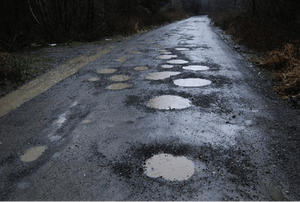Potholes, Delays & Frustration: What’s Going On With UK Roads?
- Martin Johnson

- Aug 1
- 2 min read

If you’ve driven anywhere in the UK recently, you’ve probably experienced it: the sudden jolt of hitting a pothole, the endless roadworks that seem to last forever, or the worn-out lane markings that disappear the moment it starts raining. For a developed country, the current state of our roads is, frankly, embarrassing.
From rural B-roads to inner-city streets, Britain’s road network is showing its age—and drivers are paying the price.
Potholes: The Nation’s Most Hated Obstacle
Let’s start with the pothole problem. They’re not just a nuisance—they’re damaging wheels, suspensions, and bank accounts. The RAC reported a surge in callouts for pothole-related damage in recent years, with thousands of drivers suffering punctures, cracked alloys, and worse.
According to local councils, budget constraints have made it difficult to keep up with road maintenance. While temporary patch jobs keep things going, they’re often short-lived. One hard frost or heavy rain later, and the same crater is back—often bigger and deeper than before.
A Budget Black Hole
So why can’t we fix the roads properly? It often comes down to funding and priorities. Councils have faced severe budget cuts over the last decade, and road maintenance has frequently been sidelined in favour of other critical services.
Even when money is allocated, it often goes into short-term fixes instead of long-term resurfacing. The result? A cycle of deterioration and repairs that costs more in the long run and causes constant disruption for drivers.
Roadworks: Always There, Rarely Moving
It’s not just the potholes. Drivers are also fed up with roadworks that seem to pop up everywhere and never end. Whether it's utility companies digging up the road (again), major highways being widened, or temporary traffic lights controlling a single workman and a wheelbarrow—it all adds up to delays, congestion, and stress.
And let’s not forget the seemingly endless resurfacing projects on motorways like the M6 or M25, where sections are closed for months on end, often with reduced speed limits and minimal visible progress.
Safety Concerns
Worn-out road markings, damaged signage, and crumbling verges aren't just ugly—they're dangerous. Especially for cyclists and motorbike riders, potholes and debris can pose serious risks. Poorly maintained roads reduce visibility, increase the risk of collisions, and make it harder for emergency vehicles to respond quickly.
Is There Light at the End of the Tunnel?
There are efforts underway to improve things. The UK government has promised billions in funding for road improvements, especially after pausing HS2’s northern leg and diverting some of that budget to regional infrastructure. Some councils have trialled longer-lasting materials and AI-driven pothole detection tech, but we’re yet to see widespread benefits.
What’s missing is a nationwide, consistent approach to preventative maintenance. Patching holes after they form is always going to be more expensive (and disruptive) than maintaining roads proactively.
The Bottom Line
Britain’s roads are in a state of slow decline, and it's ordinary drivers who are footing the bill—through damaged vehicles, longer commutes, and higher insurance premiums. It's time for infrastructure to get the attention (and funding) it truly deserves.
Until then, it’s pothole-dodging season all year round.
Have you had a close call—or a car bill—thanks to poor road conditions? Share your story in the comments. It’s time drivers' voices were heard.













Comments